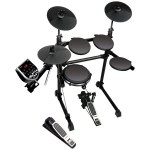
Essentially, there are four most typical ways that most music is organized. This is an explanation of what they are, how they feel, how to use them in your training, and public playlists for each of them.
What exactly are the four feels? Math and breakdown…
Music is on a spectrum of a wide variety of tempos, and it is also broken down rhythmically in various ways. Essentially, all music begins with a constant steady pulse. Think quarter notes, eighth notes, or whole notes… now take away the definition we’ve assigned to them, and we’re left with just a steady pulse at some tempo.
You can find compatible pulses, by doubling or tripling the speed: playing two notes or three notes for each original note. Or you can find other compatible pulses by cutting the original pulse speed in half or in thirds, or even fourths, sixths, etc.
Luckily, the relationship between pulses that are compatible is pretty simple. They are almost always found by using either multiples / divisions of two or three.
The Breakdown
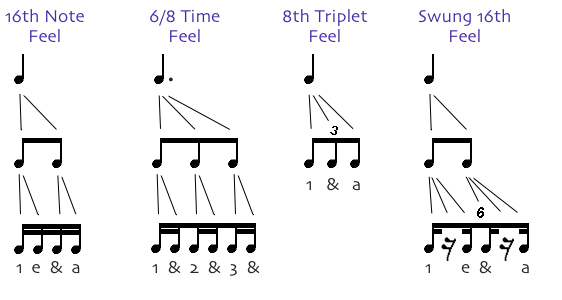
Each category of feel is made of a certain recipe of rhythmic divisions, as illustrated above. All the rhythms in a song belonging to one of these feels will be made using the types of notes shown in the breakdown below. As mentioned earlier, these don’t cover all the territory in music – but they cover most of it, and as a drummer it’s important to learn how to play in each of these feels.
Popular Example Songs In Each Feel
Songs in 16th Note Feel: “Back In Black” (AC/DC), “Smells Like Teen Spirit” (Nirvana), “Basket Case” (Green Day)
Songs in 8th Triplet Feel: “Higher Ground” (Stevie Wonder)(Red Hot Chili Peppers), “Some Kind Of Wonderful” (Grand Funk Railroad), “Gold On The Ceiling” (Black Keys)
Songs in 6/8 Time Feel: “Nothing Else Matters” (Metallica), “The Kill” (30 Seconds To Mars), “Judith” (A Perfect Circle)
Songs in Swung 16th Note Feel: “Superstition” (Stevie Wonder), “The Letter” (Joe Cocker), “Rag Doll” (Aerosmith), “Too Much” (Soullive, Nigel Hall)
Further explanation of differences between each feel
In case this clarifies, the 6/8 time feel is almost like a slow version of the 8th triplet feel, where each note of the triplet is doubled and the rhythms in a song are based on this framework. I associated songs with the 8th triplet feel whenever the song’s fastest rhythms were based on the triplets themselves, usually at higher tempos. The criteria I used to categorize something in the 16th triplet feel was that the song’s rhythms are ‘swung’, meaning they are based on a framework of 16th triplets with the middle note of each triplet removed – like a ‘shuffle’ rhythm.
Playlists in each feel
Here are some Spotify playlists with songs in each specific feel! All of these playlists are works in progress.
16th Note Feel Playlist
8th Triplet Feel Playlist
6/8 Time Feel Playlist
Swung 16th Feel Playlist
Other Useful Playlists by Adam
(These are also works in progress)
Odd Time Feel (5/8, 5/4, 7/8, 7/4, 9/8, 11/8 etc.)
Triple Triplet ‘9’ Feel
Jazz Playlist
Jungle Music (Drum And Bass)
Music Notation Of Each Feel
These are some examples of what drum music looks like in each of the four feels. Here are some examples of grooves, rhythms, and groove-fill combinations. (Excerpts from “Play Drums Now: The Ultimate Guide”)
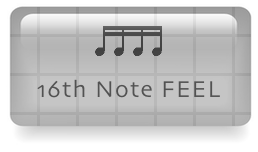
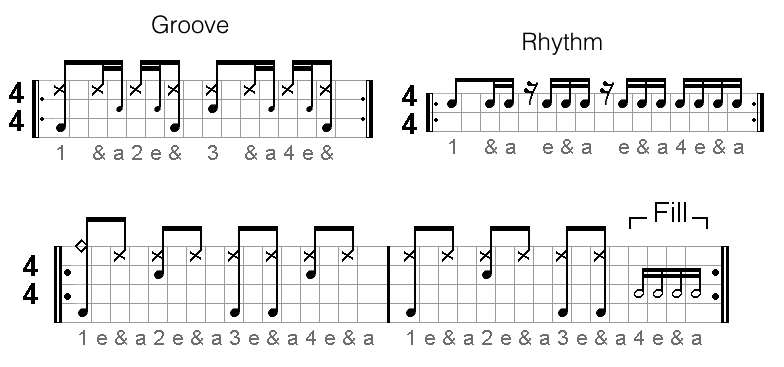

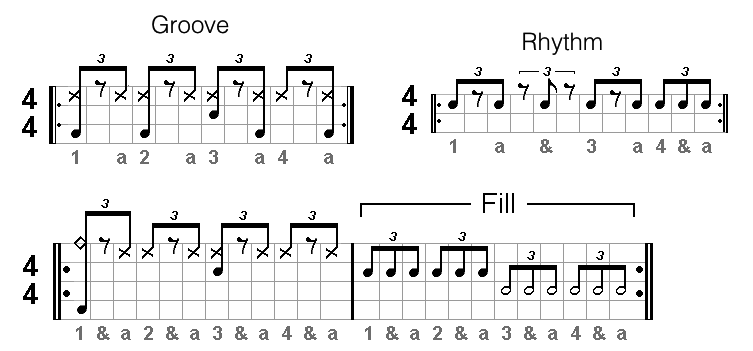
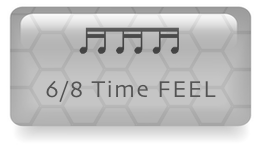
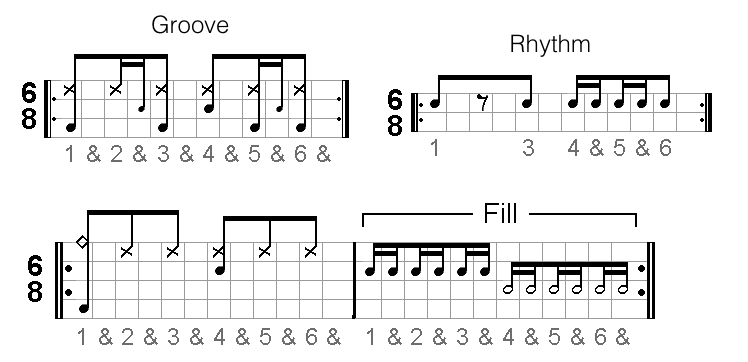
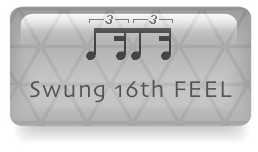

More songs belonging to each category can be found on the Song List By Tempo page.
Shortcut To Versatility
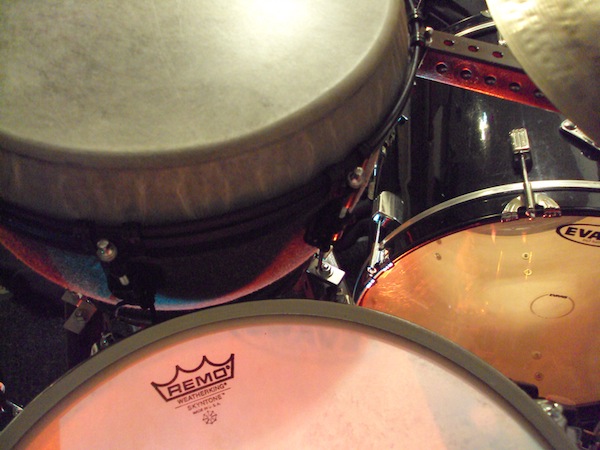
As a drummer, of course you will want to stretch your abilities in various directions and be as versatile as possible. Most people think that learning different genres of music is the main option for gaining versatility. However, there is a much more important type of versatility that I encountered in teaching situations. Students who came to me and were already able to play all kinds of styles – rock, funk, jazz, latin, metal, etc. – would occasionally have trouble with certain songs in 6/8 time or a swung 16ths feel, for example. I realized that a much more important foundation than learning musical styles is to learn all the different types of rhythmic breakdowns – the ‘four common feels’ of music.
‘Four Feels’ Is Just A Starting Point, For Training Purposes
There are more feels in music than these four can cover. When I was deciding how to create these categories, and figuring out how many there should be, it wasn’t easy – there’s a lot of grey area, where a song could be categorized in more than one feel. And some music is a blend of two or more of these feels, for example when 16th notes are ‘slightly swung’ (we’ll talk about that shortly). Other music is outside these categories altogether. But, 90% or more of popular music fits into one of these feels, so they pretty much describe all that’s out there! Plus, the main purpose of having different categories isn’t to label music, it’s for use in training drummers.
You see, if a drummer learns to play in each of these feels, they will be prepared for most any music they encounter. By learning how to play rhythms, combine grooves and fills, and come up with creative ideas in each category, drummers can become very versatile very quickly and create a perfect foundation for the rest of their drumming career.
Unfortunately, most of the drumming and drum-instruction community focuses on styles of music when improving versatility, and disregards the necessary training in these different rhythmic modes of playing.
Feels can have different time signatures
Time signature only indicates the length of a measure, not its feel. The feel just determines what kind of rhythmic breakdown applies to those time signatures. According to the categories I’ve made, many songs in 12/8 and 6/8 time signatures have an ‘8th triplet’ feel, while others have a ‘6/8 time’ feel. There are plenty of songs in a 4/4 time signature from each of these four categories of feel. Other songs may occupy more than one category of feel, or translate into several different time signatures… there are plenty of exceptions! Don’t let this system confuse you, it’s only a reference point to help you train your drumming skills in a complete way to gain versatility.
‘Straight’ vs. ‘Swung’
These terms are common among musicians, and they refer to the timing style of pairs of notes. Straight notes are all equally spaced in time. Swung notes are aligned with the first and last notes of a triplet, so the middle note is rarely or never played. All the rhythms in each of these feels are based on its timing style.

‘Slightly swung’
One area of drumming skill to practice, once you get used to these four feels, is the type of music that blurs the line between the 16th note feel and the 16th triplet (‘swung 16th note’) feel – the ‘slightly swung’ feel. A slight swing is somewhere in between straight and swung, kind of a blend between these feels, and many songs utilize this style of having a ‘swing factor’ of less than 100%. “I Shot The Sheriff” and “Waiting In Vain” (both by Bob Marley), as well as “Drive” (by Incubus) are good examples of this feel.
